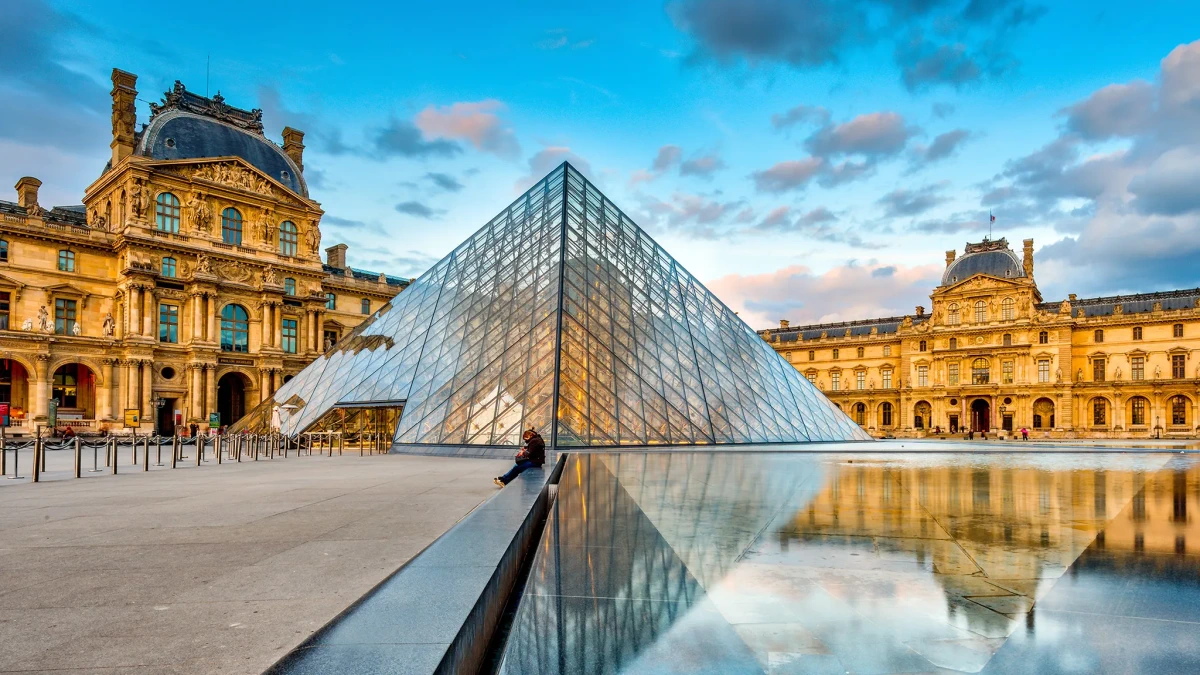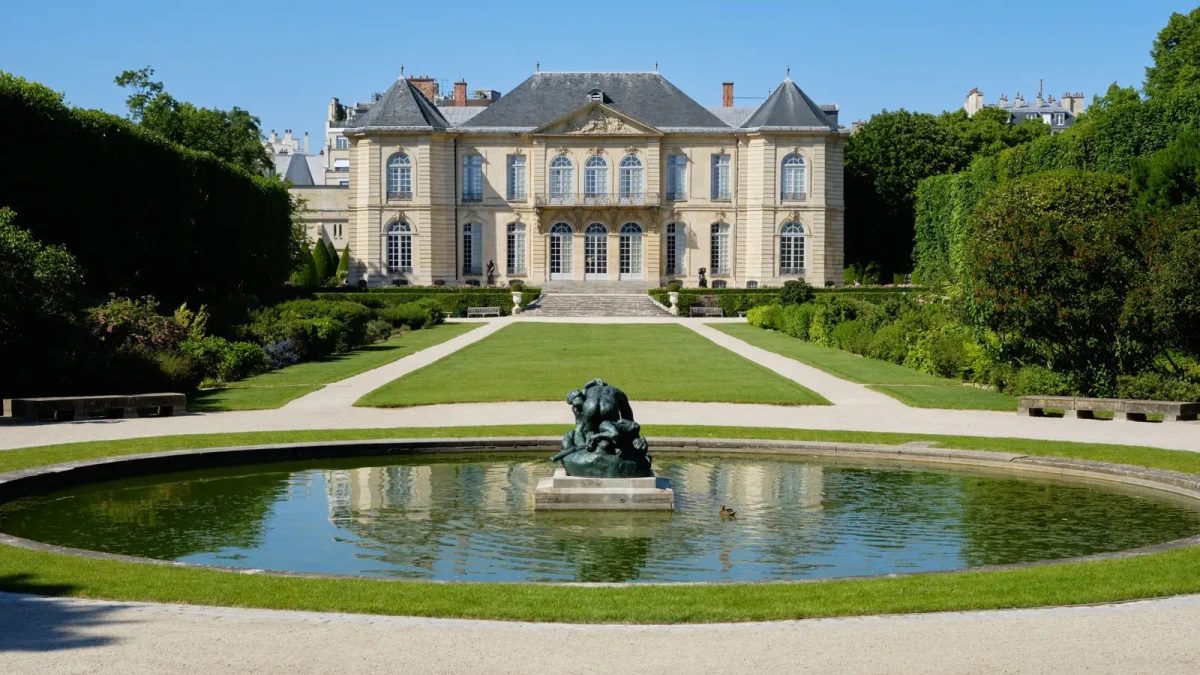Welcome to the captivating world of Sainte Chapelle Paris, an architectural gem nestled in the heart of the vibrant city. This article is your comprehensive guide to everything you need to know about this historical masterpiece, from its intriguing history to the intricate details of its design. Whether you're a history enthusiast, an art lover, or simply curious about the wonders of Paris, Sainte Chapelle is sure to leave you awe-inspired.
Note: This article contains affiliate links. In case you purchase something through one of these links, we may receive a small commission at no extra cost for you. Thank you for helping us keep creating the free content on this website!
A Glimpse of History and Architecture
Sainte Chapelle in Paris, also known as the Holy Chapel, was commissioned by King Louis IX in the 13th century. This stunning Gothic chapel is renowned for its intricate architecture, soaring ceilings, and most notably, its magnificent stained glass windows that depict biblical stories in vivid colors.
The Sainte Chapelle, a jewel of Gothic architecture, stands as a testament to the intricate interplay between history and architecture. This exquisite chapel has not only withstood the test of time but also continues to captivate visitors with its ethereal beauty and historical significance.
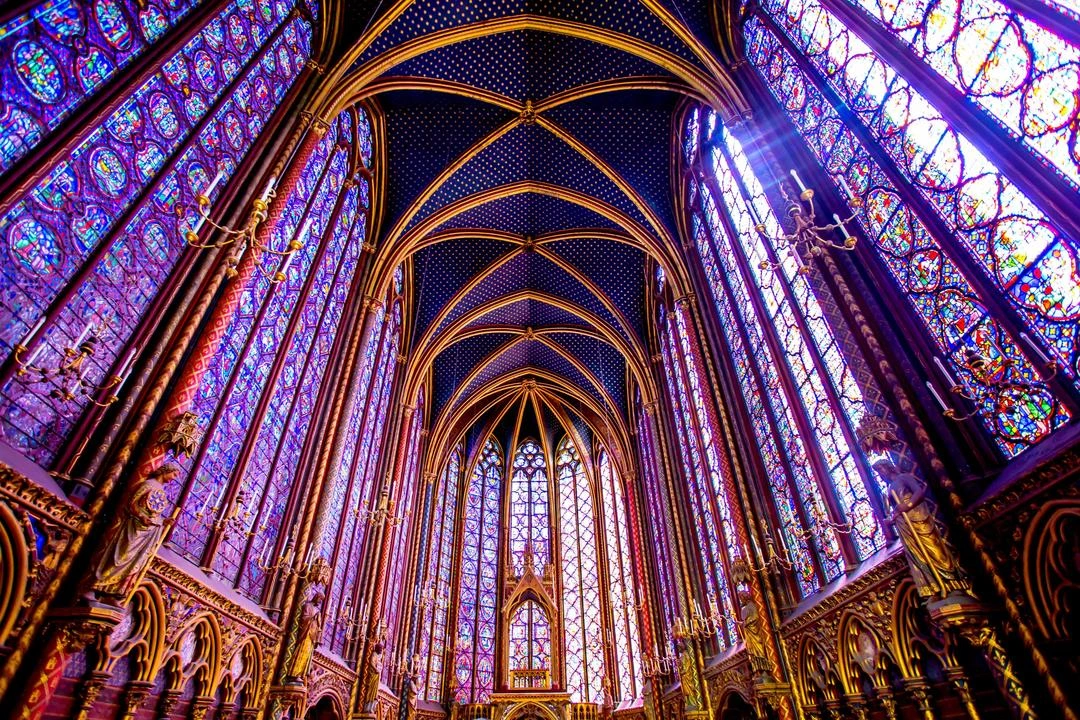
The construction began in 1241 and was completed in 1248. The chapel was intended to house precious religious relics, most notably the Crown of Thorns, acquired by Louis IX, which held immense religious and political importance.
The Sainte Chapelle's significance extends beyond its architectural and artistic marvels. It serves as a symbol of medieval monarchy's close association with religion and power. The chapel's role as a repository for sacred relics underscored the king's divine right to rule, as he was the protector of such holy artifacts. Furthermore, the chapel's continued existence despite various historical challenges, including the French Revolution, speaks to its enduring cultural and historical importance.
Unveiling the Architectural Marvel of Sainte Chapelle
The architectural brilliance of Sainte Chapelle Paris lies in its Gothic design, characterized by its pointed arches, ribbed vaults, and flying buttresses. The chapel is divided into two tiers—the lower chapel, intended for the royal staff, and the upper chapel, a true masterpiece that served the king and his guests.
The lower chapel, dedicated to the Virgin Mary, features a more subdued design with its rib-vaulted ceilings and slender columns.
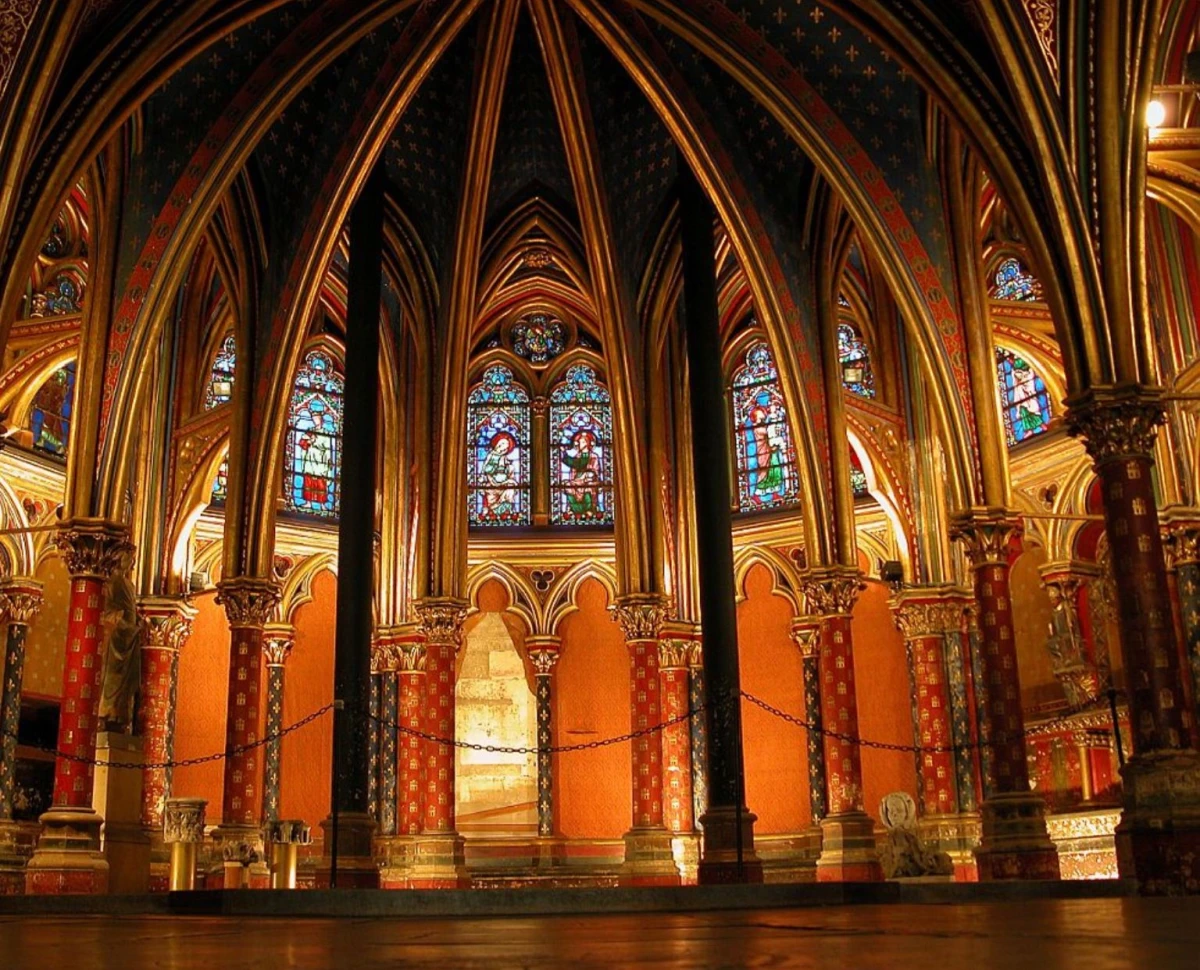
However, it is the upper chapel that truly takes one's breath away. Its most distinguishing feature is the stunning stained glass windows that cover nearly the entire wall space. These windows depict biblical stories, from Genesis to the Passion of Christ, in a kaleidoscope of vibrant colors. The sunlight streaming through these windows creates an otherworldly atmosphere, making visitors feel as if they are walking amidst a living, breathing work of art.
The stained glass windows of Sainte Chapelle serve not only as artistic marvels but also as historical and theological narratives. At a time when literacy was limited, these windows were visual aids that conveyed religious stories to the masses. The windows also reflect the shifting cultural and religious dynamics of the medieval period. They depict not only scenes from the Bible but also figures from both the Old and New Testaments, highlighting the continuity of the Christian faith.
Step into this extraordinary glass structure, a marvel of immense bays with vertiginous proportions.
Beyond the audacious and groundbreaking design of the Sainte-Chapelle, what strikes the observer at the very first glance is the perfect blend of weightlessness and submersion in a realm of gleaming gold and vibrant hues. The upper chapel consists of fifteen immense bays with staggering dimensions, with two-thirds of them originating from the Middle Ages.
Commissioned personally by King Louis IX, the future Saint Louis, the Sainte-Chapelle serves as his private chapel nestled in the heart of his chambers within the Palais de la Cité, the primary abode of the French monarchs in Paris.
In Saint-Louis's time, a remarkable collection of 22 relics graced his possession. Today, however, only three endure the relentless march of time: a mere fragment of the holy cross, a solitary nail, and the sacred crown of thorns. These invaluable remnants have found their sanctuary within the treasure trove of Notre-Dame de Paris. Gone are the days when the Sainte-Chapelle cradled these cherished relics.
A unique set of stained glass windows
Amidst the tapestry of history, fifteen stained glass marvels from the 13th century come to life. Each window is a symphony of symbolism, adorned with nods to royalty: a tapestry of coronations, backdrops and borders adorned with fleurs-de-lis and the castles of Castile. Amidst these, Louis IX emerges, adorned in the sacred crown, entwined with scenes of battle and idolatry. These intricate fragments evoke the purpose that stirred the king as he embarked on a crusade, all following the consecration of the radiant Sainte-Chapelle.
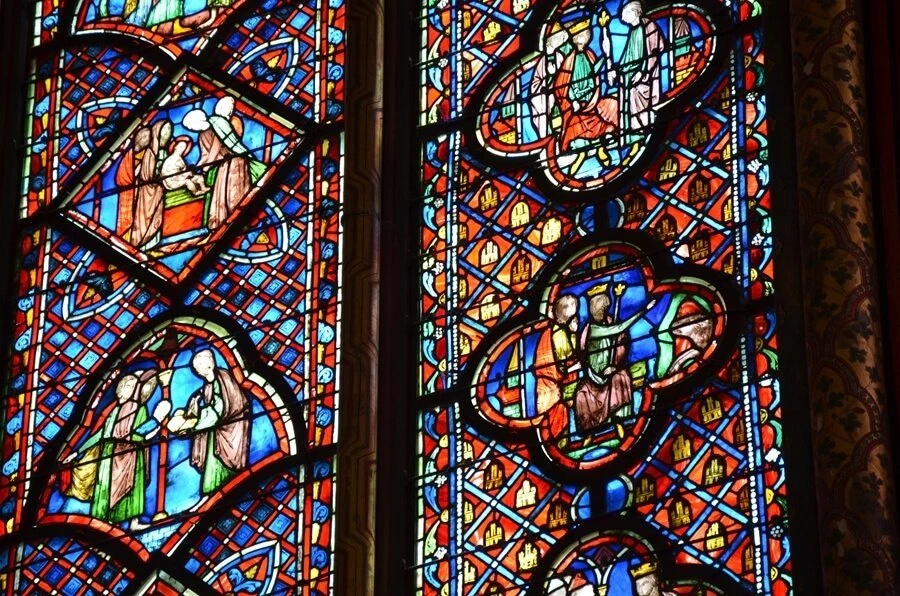
Yet, don't envision the devout souls of the 13th century poring over each detail of these images you now encounter. Fear not the plethora of scenes that grace the sanctified halls of the Sainte-Chapelle. These stained glass stories are not chapters to read, but living brushstrokes to behold – a cascade of illumination in the monument's embrace!
This illumination forms the heart of Sainte-Chapelle's stained glass, casting its divine glow through the tapestry of scripture. The glass's palette is a symphony of reds, blues, twin shades of green, two royal purples, a golden hue, and a scattering of translucent fragments. This chromatic harmony knits together the myriad narrative medallions, painting a tale woven from light.
The Rose Windows of Sainte Chapelle: A Divine Kaleidoscope
The rose windows of Sainte Chapelle are nothing short of spectacular. The intricate patterns and delicate shades of blue, red, and gold create a mesmerizing play of light within the chapel. The "Rose Window of the Passion" narrates the events leading to Christ's crucifixion, while the "Rose Window of the Apocalypse" presents scenes from the Book of Revelation.
Spanning an impressive width of 9 meters, it enfolds you within a tapestry of stone, intricately shaped like "flames," a display of artistry that is notably intricate and emblematic of the exuberant Gothic style of the 15th century.
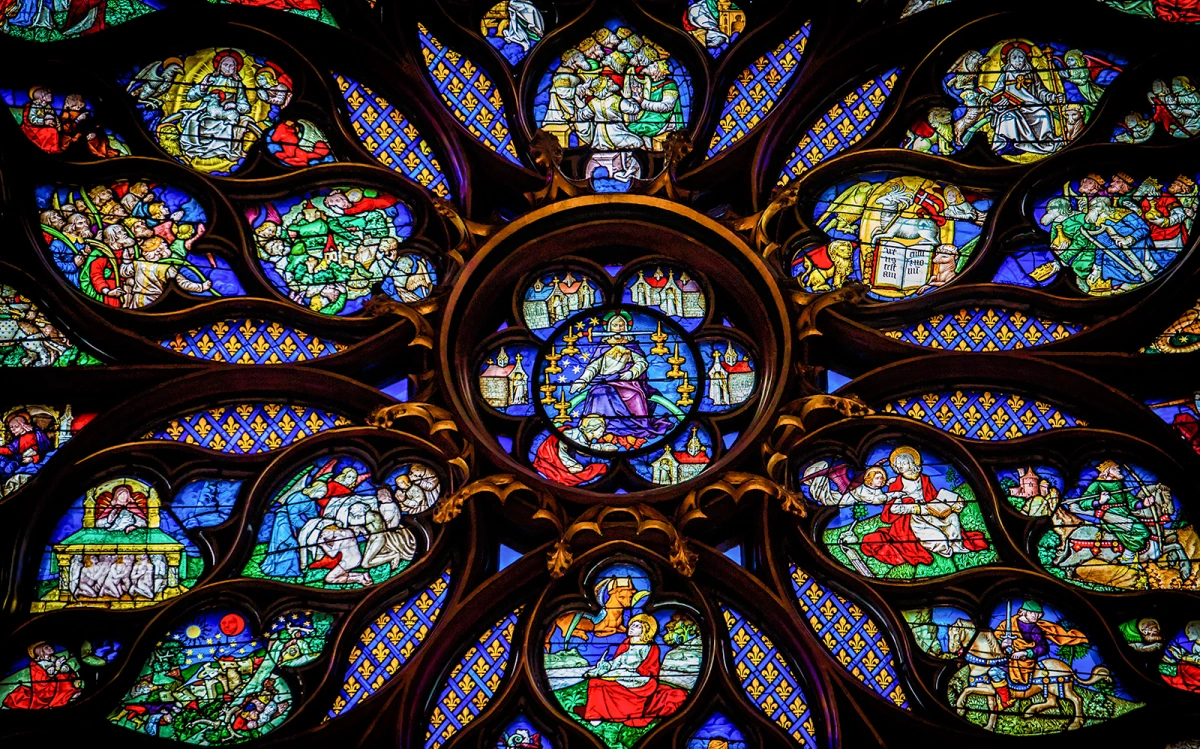
This present-day rose window is a dedication to the Apocalypse, painstakingly reconstructed during the reign of Charles VIII around 1485. Notably, within one of the medallions at the lower left, you can discern the crowned "K" of Karolus (Charles), replacing the original 13th-century rose window that bore a similar theme. The 15th-century architects chose to craft this masterpiece in the flamboyant style, mirroring the contemporary artistic sensibilities of their era.
A discerning eye reveals a shift in the predominant colors. The hues of blue and red that once held sway in the surrounding windows have ceded their dominance to the vibrant interplay of yellow and green. The advent of silver yellow, a metallic oxide capable of imbuing glass with vibrant color, during the 14th century has wrought a revolution in the art of stained glass, forever altering its course.
Amidst the ensemble of 87 panels constituting it, this rose stands as an exquisitely preserved marvel, with only 9 panels undergoing restoration during the nineteenth century.
Gracefully adorning the western facade, a convention often observed in ecclesiastical edifices, the rose window assumes the role of the final conduit, ushering light into the sanctum of the upper chapel's interior.
The Apocalypse's rose window serves as a testament, particularly poignant for adherents of Christianity, to the triumphant return of Christ and the dawning of his sovereign dominion—the Celestial Jerusalem.
Within the intricate tapestry of symbols encapsulating the essence of the Apocalypse, the oculus reveals a visage of profound significance: the enthroned Christ, his countenance pierced by a sword. At his feet, the prophet St. John, the recipient of Christ's revelations elucidating the divine narrative of his era and the imminent emancipation of God's people.
Peering into the depths of the oculus, one can discern two of the four harbingers of the Apocalypse—the ominous horsemen. To the left, the figure of a white horseman (symbolizing death) emerges from the maw of a dragon, while to the right, a horseman bearing scales (representing famine) takes his place in the tableau.
The relics were kept in a silver chest that cost 2.5 times more than the Sainte-Chapelle itself.
The Jewel-Like Detailing
The meticulous detailing of the stained glass windows is a testament to the craftsmanship of the era. The glass pieces are intricately cut and painted, producing a jewel-like effect when illuminated by the sun. The play of colors and the interplay between light and shadow make these windows a true masterpiece of artistry and devotion.
Intricately woven within the stained glass windows of the Sainte-Chapelle, a grand total of 1113 scenes come alive, each narrating its own tale in a visual symphony. Comparable to a colossal tapestry of medieval times, this intricate panorama vividly portrays a multitude of biblical episodes, akin to the pages of an oversized, age-old comic book. The journey through time commences at the northern frontier with the tales of Genesis, gracefully winding its way through the epochs, ultimately culminating at the western horizon where the rose window of the Apocalypse elegantly resides.
The Sainte-Chapelle's narrative unfolds majestically across the North and South façades, collectively known as the "historic cycle." Within this hallowed space, the Old Testament's principal personas step forth from the shadows of history and myth, seamlessly blending their essence with the vibrancy of the stained glass canvas. On the northern front, a procession of illustrious figures emerges—Adam and Eve, Noah, Abraham, Moses, and the revered kings of Israel. Meanwhile, the southern visage hosts a chorus of equally venerable characters—Judith, Job, Esther, and the legendary David. And it is on this very southern flank, within the confines of the ultimate window, that the monarch himself graces the scene—a tangible link, forging a spiritual bridge between his subjects and the divine.
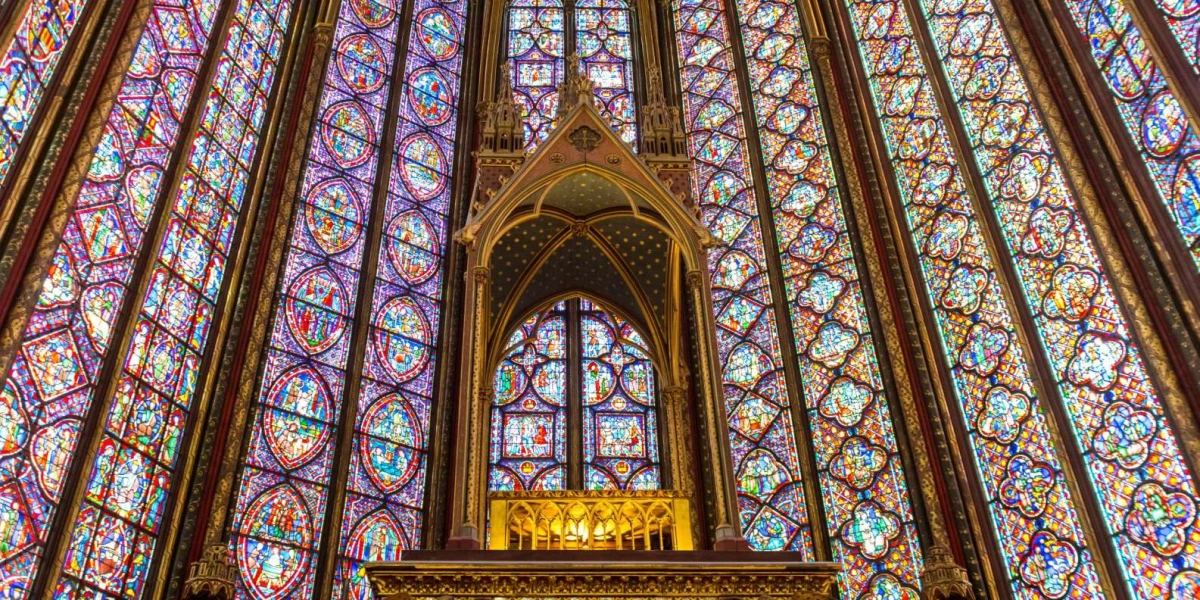
Moving inward, the choir's stained glass windows become a repository of the prophetic cycle—an ensemble of mystical figures and sacred visions. Here, the likes of Daniel, Saint John the Baptist, Ezekiel, the lineage of Jesse, and the revered Isaiah stand united, converging upon the central tableau—the window of Passion. Within this hallowed frame, the anguish and tribulations of Christ unfurl with unparalleled intensity, a visual chronicle capturing the gamut of emotions from his heart-wrenching apprehension to the transformative crescendo of Pentecost.
Sculpted decorations in the Sainte-Chapelle
Take a moment to admire the sculpted decor, which, thanks to medieval master builders and 19th-century restorers, magnifies the monument's sumptuous architecture. Although the Virgin and Child in the lower chapel portal is a 19th-century work by the artist Geoffroy-Dechaume, it recalls the beauty and grace of its medieval forebears.
As for the Christ bénissant, by the same artist, leaning against the trumeau of the portal of the upper chapel, it recalls the Beau Dieu of Amiens Cathedral in its gentle solemnity.
The 13th-century artists who sculpted the hundred or so capitals and brackets in the upper chapel displayed a keen sense of naturalism.
If you're a botanist, you'll notice the profusion and variety of plant life on the capitals of the upper chapel: thistles, buttercups, hawthorns, vines, hollies and even rose bushes are all different from one another. Occasionally, you'll come across a crutching bird or a fantastic animal lurking in the shadows of these sculptures. Mirrors of nature, they bear witness to the enduring wonder of 13th-century man at Creation.
Last but not least, you'll notice the presence of 12 statues, leaning against the pillars that support the vault: these are the apostles, the true pillars of the Church.
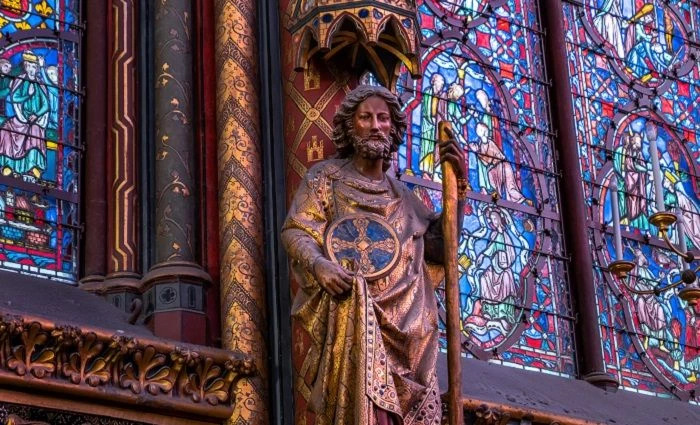
Each figure holds a disc marked with a cross, a reminder of the chapel's consecration. Some are barefoot, like God or Christ, the mark of divinity in the iconographic tradition of the 13th century, while others have their feet covered by their overabundant drapery. They are outstanding examples of the "classical" Gothic style that flourished at the time of Saint Louis.
The apostles are nicknamed "philosopher" or "melancholic". Few of them are identifiable, but you'll recognize Saint Peter carrying the key and the cross, at his side in the apse, Paul, carrying a sword, and John, the most youthful and beardless of them all, with his tender smile.
Painted decorations in the Sainte-Chapelle
Visitors to the Sainte-Chapelle are greeted by an extraordinary polychrome universe, where the multitude and intensity of colors astonish.
Amidst the passage of time and the tumultuous embrace of history, the once-vibrant painted adornments from the 13th century that graced the lower chapel have regrettably waned into obscurity, their brilliance dulled by the relentless floods of the Seine River.
The murals that unfold before the gaze of modern-day explorers bear witness to a rekindling of creative fervor during the 19th century, an earnest endeavor to breathe life anew into the tapestry of the past.
With an unwavering dedication akin to a time-traveling artist, the restorers, in their pursuit of authenticity, have woven a vibrant tapestry that mirrors the very essence of the Middle Ages. The color palette they employed - a rich tapestry of blues, reds, and golds - channels the very spirit of the 13th century, invoking a sense of connection across the ages.
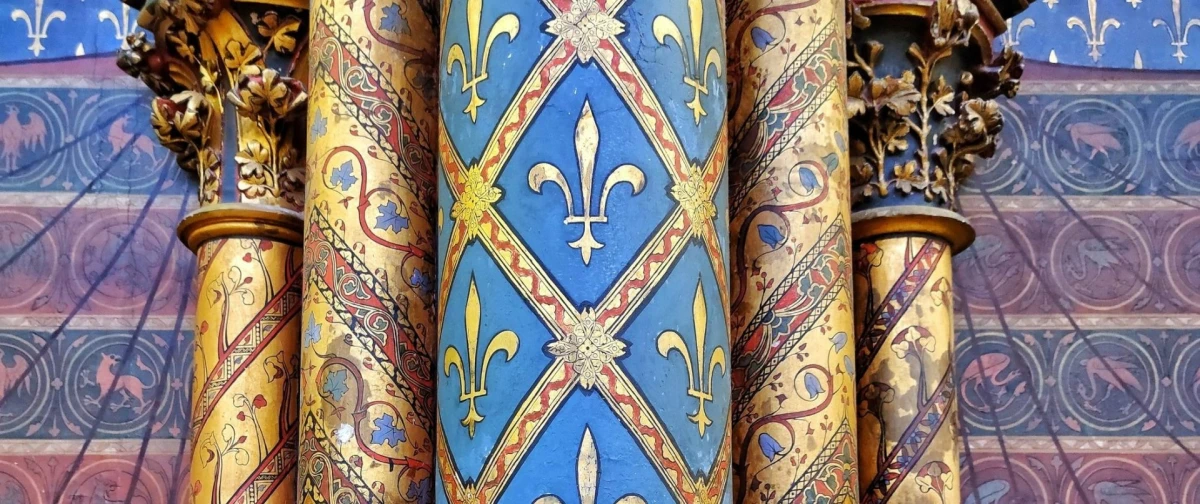
Embarking on a journey through the lower chapel, one's gaze is met with an enchanting sight: columns and ceilings adorned with the regal fleur-de-lis and the steadfast castles of Castile. These emblems stand as a nod to the Spanish heritage of St. Louis' mother, the indomitable Blanche of Castile, bridging the chasm between lands and epochs.
Do not forget to marvel at one of Paris's most ancient murals, a masterpiece concealed within the depths of the lower chapel, nestled above a portal that once served as the gateway to the hallowed sanctum of the Chartres treasure, a repository of regal archives. Behold, an emotionally charged tableau unfolds—one of the most poignant moments in the Virgin's life, the Annunciation. Here, the ethereal messenger Gabriel unfurls the divine revelation of Mary's impending maternity.
Venture forth into the upper chapel, where the 19th century ushered in a renaissance of the painted motifs, meticulously restoring the vestiges of medieval artistry to their former glory.
As you traverse this hallowed ground, you shall discern an intriguing semblance to the artistic motifs adorning the lower chapel. Yet, cast your gaze skyward, and the transformation shall astound you—an expanse now festooned with a celestial canvas, a realm befitting the sovereign. When the monarch tilts their gaze heavenward, they are greeted by the vast expanse of the celestial sphere, the dominion of the Almighty.
Turning your attention to the 44 medallions ensconced within the graceful arcatures, you'll marvel at these miniature masterpieces, meticulously etched onto the stony canvas, their backgrounds chiseled to perfection, adorned with the delicate artistry of inlaid glass. Through the ravages of time, some may bear scars, yet their depictions remain, depicting the valorous Christian martyrs—Saint Sebastian, his form pierced by a volley of merciless arrows, and Saint Catherine of Alexandria, forever bound to the ever-turning wheel of fate.
Witnessing History: Sainte Chapelle's Significance
A Royal Reliquary
Built to house significant Christian relics, Sainte Chapelle served as a symbol of King Louis IX's piety and devotion. The most revered of these relics was the Crown of Thorns, believed to be worn by Jesus Christ during the crucifixion. The chapel's purpose was to provide a sacred space for these relics and to inspire devotion among the king's subjects.
An Architectural Influence
Sainte Chapelle's unique architectural style had a profound impact on the development of Gothic architecture across Europe. Its emphasis on height, light, and intricate detailing set a precedent for future cathedrals and chapels. Architects and builders drew inspiration from its design elements, contributing to the spread of the Gothic style throughout the continent.
Practical Information for Visitors - Tips and tricks
Before embarking on your journey to Sainte Chapelle Paris, here are some practical tips to enhance your experience:
- Sainte Chapelle is open to visitors throughout the year. It's recommended to book your tickets online in advance to avoid long queues. The chapel is typically open from early morning until late afternoon, allowing you ample time to explore its beauty.
- To truly immerse yourself in the history and significance of Sainte Chapelle, consider joining a guided tour or using an audio guide. Knowledgeable guides provide insights into the chapel's history, architecture, and the stories behind its stained glass windows.
- As a place of worship, Sainte Chapelle maintains a modest dress code. It's advisable to dress respectfully, covering shoulders and knees. Unfortunately taking pictures inside the chapel is actually not allowed.
Conclusion
In the heart of Paris stands a testament to artistic brilliance and historical significance—Sainte Chapelle Paris. From its awe-inspiring stained glass windows to its intricate Gothic design, this architectural marvel continues to captivate visitors from around the world. As you stand within its hallowed walls, surrounded by a kaleidoscope of colors and centuries of history, you can't help but feel the weight of its importance and the beauty of human creativity.
Don't miss the opportunity to immerse yourself in the enchanting world of Sainte Chapelle Paris. Plan your visit, embrace the magnificence, and create memories that will linger long after you leave.
FAQs
How old is Sainte Chapelle Paris?
Sainte Chapelle Paris was constructed in the 13th century, making it over 800 years old.
Can I visit Sainte Chapelle with children?
Absolutely! Children are welcome to visit Sainte Chapelle, and they will likely be mesmerized by the colorful stained glass windows.
Is Sainte Chapelle wheelchair accessible?
While the lower chapel is accessible, the upper chapel can only be reached via a narrow staircase, making it challenging for wheelchair users.
Can I attend a worship service at Sainte Chapelle?
Yes, Sainte Chapelle occasionally hosts worship services and concerts. Check the schedule in advance to see if there's an event during your visit.
Are there any nearby attractions to visit after Sainte Chapelle?
Certainly! Sainte Chapelle is located on the Île de la Cité, which is also home to the Notre-Dame Cathedral and the Conciergerie—a former royal palace turned prison.
How can I get to Sainte Chapelle using public transportation?
Sainte Chapelle is well-connected by public transportation. You can take the metro to the Cité station or use buses that stop nearby.
Site location: 10 Bd du Palais, 75001 Paris
GPS coordinates: 48.855065, 2.345570
Google Photos: Click here
For more content and exciting articles, follow our site, where we regularly update our column to bring you the best ideas for events or things to do in Paris!






